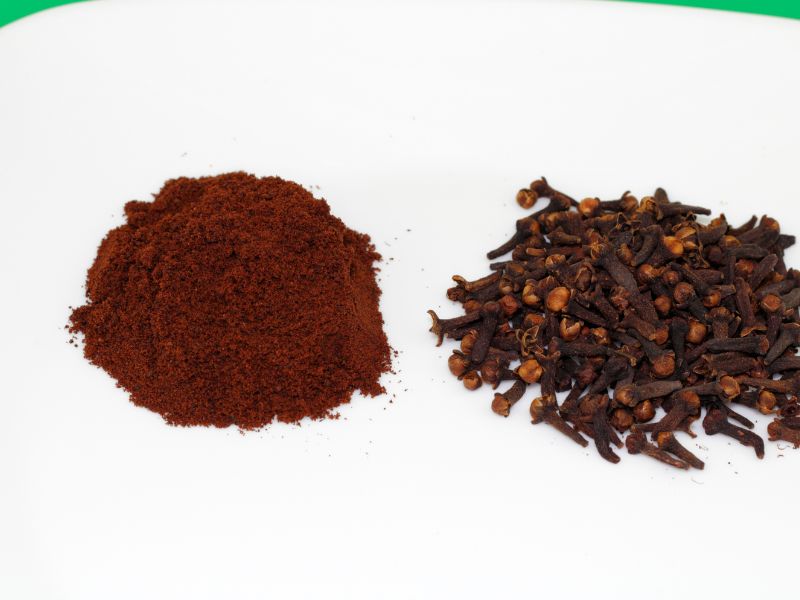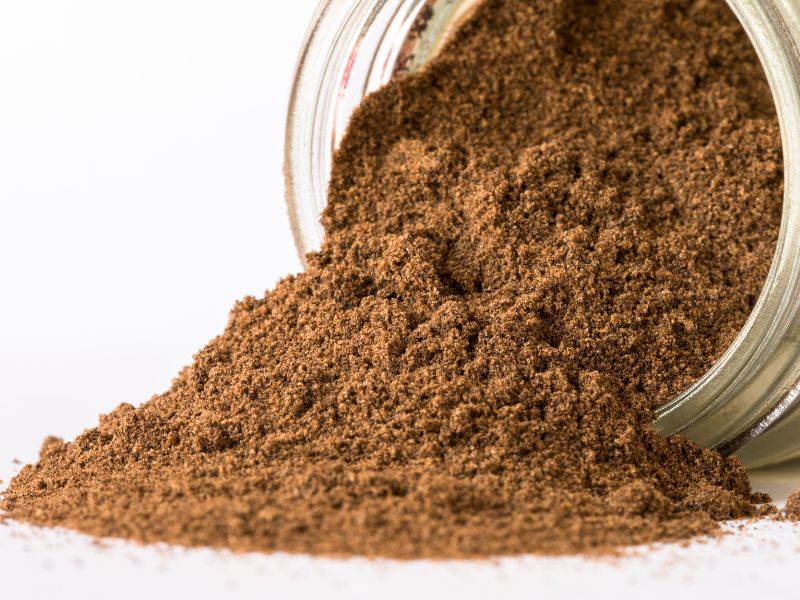Ever noticed how your ground nutmeg sometimes sticks together in lumps? You might wonder, “Why does my ground nutmeg clump together?” Simply put, it’s because nutmeg can soak up moisture from the air. But don’t worry! With a few easy tricks, you can keep it smooth and ready for your recipes.
What is Nutmeg?

Nutmeg is the seed of the Myristica fragrans tree, native to the Banda Islands in Indonesia but now cultivated in various parts of the world. The tree actually gives us two spices: nutmeg (the seed) and mace (the reddish, lace-like covering of the seed).
Nutmeg’s warm, sweet, and slightly nutty flavor makes it a versatile spice. It’s used in both sweet dishes, like pies, puddings, and cookies, and savory ones, such as stews, sausages, and spiced meats. It’s also a key ingredient in various spice blends, like garam masala and pumpkin spice.
Ground Nutmeg vs. Whole Nutmeg
Ground nutmeg is easy to use but can lose its taste quickly because more of it touches the air.
Whole nutmeg keeps its strong taste for a longer time. When you grate whole nutmeg, it tastes fresher and better.
As an Amazon Affiliate, I may earn a commission from qualifying purchases.
Full Disclosure
Grating Nutmeg
For those who choose whole nutmeg, mastering the art of grating is important. Using a microplane or a special nutmeg grater, one can get a fine, fluffy powder that perfectly blends into dishes, releasing its aromatic oils.
Watch the video below
Why Does My Ground Nutmeg Clump Together?
When we say spices like nutmeg “clump,” we mean how the tiny bits stick together because of moisture and air. But let’s explore this just a little bit more.
Moisture: The Primary Culprit
Nutmeg, a popular spice in many kitchens, is made of tiny pieces. These pieces have a tendency to stick or clump together, especially when they come into contact with water from the air. This is because nutmeg has natural oils in it. These oils, when mixed with water, make the nutmeg even stickier. Think of it like how wet sand can be molded together, while dry sand falls apart.
Where you store nutmeg plays a big role in how it behaves. The nutmeg can easily become lumpy if you keep it in warm or damp places, like in a kitchen near a boiling pot or in areas where it rains a lot. On the other hand, in places that are super dry, the tiny pieces of nutmeg can get a static charge. It’s similar to when you take clothes out of the dryer and some pieces stick together because of static. This static can make the nutmeg bits cling to each other.
So, if you want to keep your nutmeg smooth and easy to use, it’s important to think about where you store it. Keeping it in a cool, dry place and sealed container can help a lot.
| 🍪 Preventing and Fixing Clumped Nutmeg 🍪 | |
|---|---|
| Airtight Containers | Store ground nutmeg in airtight containers to minimize exposure to external moisture. |
| Cool, Dark Places | Keep nutmeg in a cool, dark cupboard or pantry to maintain its freshness. |
| Silica Gel Packets | Place a silica gel packet in the container to absorb any excess moisture. |
| Gentle Heating | Spread clumped nutmeg on a baking sheet and warm gently in the oven to evaporate trapped moisture. |
| Mortar and Pestle | Use a mortar and pestle to grind and break apart clumps in the nutmeg. |
| Brought to You by wearebaking.com 🍰 | |
Clumped nutmeg can be a baker’s minor annoyance, but with the right techniques, it’s an issue that can be both prevented and fixed
Prevention
Storing ground nutmeg properly is crucial to maintain its quality and prevent it from clumping. One of the best methods is to use airtight containers, which shield the spice from external moisture and keep it fresh.
It’s also a good idea to store nutmeg in cool, dark places, like a cupboard or pantry, as heat and light can harm the spice and make it more likely to clump.
For those who want an added layer of protection, silica gel packets, which are commonly found in many packaged goods, can be a great addition to your spice container. These packets are designed to soak up moisture, ensuring the nutmeg remains dry; however, it’s essential to make sure the packet doesn’t touch the spice directly.
Lastly, if you have a significant amount of ground nutmeg, it’s a good practice to rotate your stock. Using the older nutmeg first can prevent it from sitting too long and becoming more prone to clumping.
Fixing the Issue
If you’ve found that your nutmeg has become clumpy, there are several methods to bring it back to its powdery form. One effective way is to spread the clumped nutmeg on a baking sheet and place it in the oven at a low temperature. This gentle heating process will help to get rid of any trapped moisture, but it’s essential to watch closely to prevent burning.
A mortar and pestle can be quite useful for those who prefer a hands-on approach. This traditional tool can grind and break up larger nutmeg clumps effectively.
Using a sieve or strainer can be the answer if you’re dealing with finer clumps. Pushing the nutmeg through a fine-mesh sieve can separate the lumps and achieve a smoother texture.
For those with a significant amount of clumped nutmeg, a blender or spice grinder can be a lifesaver. These machines’ quick pulses can break up the clumps and return the nutmeg to its original consistency.
Regular Checks and Maintenance
It’s a good habit to periodically check on your spices, including nutmeg. By giving your spice containers a quick shake and inspection now and then, you can spot any early signs of clumping, making it easier to address the issue before it becomes more significant.
Also, the cleanliness of the containers plays an important role in maintaining the quality of the nutmeg. Before storing the spice, always make sure the containers are clean and dry. Even a tiny bit of moisture can lead to clumping, so it’s very important to be thorough in this step.
With these preventive measures and solutions at hand, clumped nutmeg will be a thing of the past. Remember, the key is to create an environment where the spice remains dry and free from external factors that promote clumping.
Other Options



While ground nutmeg is a favorite for many due to its convenience, there are times when you might look for other options. Here are some alternative solutions to consider:
Opting for Whole Nutmeg
Using whole nutmeg has its perks. It keeps its taste and smell better and longer than ground nutmeg. When you grate nutmeg only when you need it, you’re sure to get the best and freshest flavor every time. Plus, whole nutmegs don’t clump together like the ground kind, and they can stay good for many years without losing their strong taste. Getting a good nutmeg grater or a microplane is worth it if you decide to go this route. They make grating easy, but always be careful so you don’t hurt your fingers.
Exploring Other Spices
Sometimes, it’s not just about replacing nutmeg but discovering new flavors that complement or enhance a dish.
Mace: Often overlooked, mace is the outer covering of the nutmeg seed and offers a flavor profile similar to nutmeg but slightly more delicate. It can be a direct substitute in most recipes.
Allspice: With a flavor similar to cloves, cinnamon, and nutmeg, allspice can be a suitable substitute, especially in desserts and savory dishes.
Cinnamon and Cloves: A combination of cinnamon and cloves can mimic the warmth and depth of nutmeg in many recipes.
Blends and Mixes
Pumpkin Spice: This popular blend, which usually contains nutmeg, cinnamon, ginger, cloves, and allspice, can be used as a substitute in recipes that call for a mix of warm spices.
Apple Pie Spice: Similar to pumpkin spice but with different proportions, this blend can offer a delightful alternative to straight nutmeg in many dessert recipes.
To elevate your pumpkin pie, why not make your own homemade pumpkin pie spice?
Liquid Alternatives
Nutmeg Essential Oil: In recipes where the spice’s flavor is more critical than its texture, a drop or two of nutmeg essential oil can provide the desired taste without the bulk of the ground spice.
Final Thoughts
Nutmeg is a spice many of us love to use because it smells and tastes great. It can be added to both sweet and savory foods. But like many things we cook or bake with, it’s good to know more about it to use it best.
It’s important to treat our cooking ingredients well. We can use them better when we learn why things like nutmeg get lumpy. There is so much to learn when it comes to baking and cooking. From stopping spices from getting lumpy to trying new tastes or ways to cook, there’s always something new to discover. Sometimes, things don’t go as planned, like when nutmeg gets lumpy. But that’s okay! We can learn to fix it or try something else. And when we find out something new or solve a problem in the kitchen, we want to tell others. Sharing what we know helps everyone cook and bake better.
Have you faced challenges with your ground spices? Or maybe you have a unique recipe using nutmeg to share? I would love to hear from you! Drop a comment below, share your experiences, And if you found this article helpful, don’t forget to share it with your fellow baking pals.
And As Always
Keep On Baking!
Taianne

I’m Taianne, the owner and operator behind We Are Baking. Baking my first cake at age 11 hooked me on creating sweet treats. Though my interest faded during childhood, it was rekindled when I married my apple pie-loving husband. I love trying new recipes, tweaking classics, and helping others learn the science and art of baking. I started We Are Baking to share tips, tricks, and favorite recipes I’ve discovered over the years. When not in the kitchen, I enjoy spending time with family and friends. My goal is to inspire others to embrace their creativity through baking. Feel free to contact me with any questions!
Taianne@wearebaking.com

